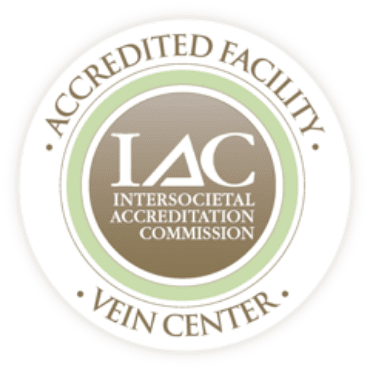Tired of the cold, snowy New England winters, Kristi Harkness and her family relocated to warmer Fort Myers in 2004. Dedicating herself as a homemaker and mother, Kristi devotes most of her time to her four sons whom she homeschools. She dearly loves her boys, but four pregnancies left her with symptomatic varicose veins in her legs.
“In addition to the bulging veins, I also had heaviness and a lot of swelling in my legs,” she shares. “I didn’t have any cramping, but it was uncomfortable for me to sit on the floor, bend over or even move around too much.
“I had a treatment on my leg veins at a local facility but wasn’t happy with my results. Then, I heard about Vein Specialists and Dr. Magnant, so I went to see him.”
Kristi reached out to Joseph G. Magnant, MD, a board-certified vascular surgeon who specializes in treating vein disorders. His practice, Vein Specialists, is dedicated to the modern evaluation and minimally invasive treatment of these disorders. Vein Specialists has offices in Fort Myers and Bonita Springs.
Dr. Magnant clearly describes what was happening in Kristi’s legs.
“Veins are the blood vessels that return deoxygenated blood to the heart and lungs,” he says. “Inside the veins are one-way valves that assist blood flow against gravity. When these valves become stressed and begin to leak, it causes blood to accumulate in the ankles or lower legs. This condition is known as venous insufficiency.
“Venous insufficiency causes the valves in the veins to fail, creating pressure that builds up in the veins. This leads to signs and symptoms such as varicose veins, swelling, heaviness, achiness or cramping, skin discoloration, ulcerations, restless legs and frequent nighttime urination.”
“Dr. Magnant performed several treatments on each leg,” remembers Kristi. “Afterward, my symptoms improved. But after about three years, the swelling in my ankles and heaviness in my legs returned. I decided to call Dr. Magnant again to see if there were any other options or follow-up treatments.
“When I saw him, he told me he had his suspicions before that I had vein problems in my pelvis, too, but he didn’t have a good way to diagnose or treat those problems at that time. He was so excited to tell me about the new procedure he now has available for pelvic vein issues. I went in at the right time.”
IVUS Advance
When Kristi initially described her symptoms to Dr. Magnant, he felt certain she had a bigger problem than the venous insufficiency in her legs. He treated what he was able to diagnose at the time, which was leaky veins below the groin. When she went back three years later with persistent symptoms, he was armed with new technology.
By that time, Dr. Magnant had begun using an advanced diagnostic tool called intravascular ultrasound, or IVUS, which allows him to examine the veins between the groin and the abdomen, near the navel. These are the common iliac and external iliac veins.
“IVUS is a catheter-based ultrasound device,” notes Dr. Magnant. “The catheter is a very slender tube with an ultrasound probe at its tip. Unlike the ultrasound we use on the legs, which evaluates the veins from the outside through the skin, IVUS goes directly into the veins.
“During a diagnostic evaluation, the IVUS catheter is inserted into the jugular vein in the neck, and a guide wire with the probe attached is negotiated through the venous system down to the designated iliac vein. This is all done using fluoroscopy guidance under local anesthesia.”
Once the catheter is in place, the information from the ultrasound probe is sent to a monitor that displays the image of the vein from within. Typically, Dr. Magnant evaluates the veins on both sides of the body.
“IVUS allows me to look at the iliac veins from the inside to identify blockages or compression,” describes the doctor. “People with blockages in these veins have a condition known as iliac vein compression syndrome.”
Iliac vein compression syndrome occurs when an iliac artery presses on the corresponding iliac vein. The artery, under pressure, squeezes the thin-walled vein against the hard surface of the spinal bones. Over time, the compression can damage the vein and lead to scar tissue formation and inflammation within the vein, causing it to narrow.
“Now, I can sit on the floor and move around much more comfortably. I also have more energy since the procedures.” – Kristi
Call Or Request An Appointment
Contact us to schedule an appointment with our expert Vein Specialists team. We will evaluate your signs and symptoms, answer your questions, and create a personalized vein care treatment plan to relieve your leg pain and enhance your life.
Schedule Your Appointment Today
“The narrowing in the iliac veins affects blood flow in the leg veins and is responsible for the persistent swelling and skin discoloration around the ankles these patients often experience,” explains Dr. Magnant. “After I’ve diagnosed iliac vein compression syndrome using IVUS, the patient returns to treat the problem with venous angioplasty.”
“Dr. Magnant was very considerate and made every effort to make me feel comfortable during the procedure,” relates Kristi. “It showed I had greater than fifty percent blockage in the iliac veins on both sides.
“After the IVUS test, Dr. Magnant spent a great deal of time with my husband and me going through the analysis and helping us understand my condition.”
From Kristi’s IVUS evaluation,
Dr. Magnant determined she suffered with pelvic congestion syndrome, a type of iliac compression syndrome. Pelvic congestion syndrome typically affects younger women in their childbearing years. Kristi’s symptoms of pain when bending or sitting on the floor were due to this syndrome.
Venous Angioplasty
To treat iliac vein compression syndrome, including pelvic congestion syndrome, Dr. Magnant again travels through the venous system, this time beginning in a leg vein, typically the femoral or popliteal vein. He guides the catheter upward into the compressed iliac vein, where he places a stent. In addition, he inflates a balloon, which enlarges the blood vessel even further.
The stent he uses is called a WALLSTENT™, and they are self-expanding. “They use radial force, which means they exert outward force at all times,” states Dr. Magnant. “Also, these stents are compressible; they can’t be crushed. The stents maintain their form and resist compression by the artery against the spine.
“The outcome is a five-lane highway that is five lanes again, rather than a five-lane highway that is being compressed to a one-lane highway. As a result, the blood that has been accumulating in the legs can escape and flow freely, and symptoms disappear.”
Because Kristi had blockage on both sides, two procedures were necessary.
“There was minimal discomfort during the first procedure on the left side, which took about three hours,” states Kristi. “Dr. Magnant inserted the catheter in my leg, and I didn’t even feel it. The room the procedure takes place in is very comfortable, and there are a lot of people there to help. I was well cared for.”
Unexpected Benefit
The angioplasty procedure and its initial recovery put Kristi out of commission for a day. But after that, her recovery was much quicker than she anticipated. The procedure also brought a result she never expected.
“Within four days, I lost five pounds,” she marvels.
“Dr. Magnant explained it was because my blood was finally able to clean itself well because it could get through my whole lymphatic system.
“After Dr. Magnant performed an ultrasound to confirm I had no blood clots from the stents on the left side, I had the same exact procedure done on the right side.”
Once the IVUS evaluation identified Kristi’s pelvic congestion syndrome, and the angioplasty procedures opened up her narrowed veins, she began experiencing symptom relief. The swelling in her legs subsided, and the pain in her abdominal region disappeared.
“I still feel the need to wear compression stockings for part of the day, but the swelling has diminished significantly. The heaviness in my legs has also improved considerably,” she reports. “We’re moving, so I’m on my feet a lot. I don’t know if I’d need the stockings if I weren’t on my feet so much.
“Now, I can sit on the floor and move around much more comfortably. I also have more energy since the procedures.”
Kristi considers her evaluation and treatment at Vein Specialists a complete success. She acknowledges the technology as well as the expertise of the physician who uses it.
“I highly recommend IVUS, venous angioplasty and Dr. Magnant!”
Request an Appointment
Please take a moment and fill out your request below and one of our staff members will be in contact within 24-48 business hours. If this is an emergency, call 911 immediately. If this is a non-emergent concern, please call the office Monday-Friday between 8am – 5pm at: 239-694-8346


1 Comment